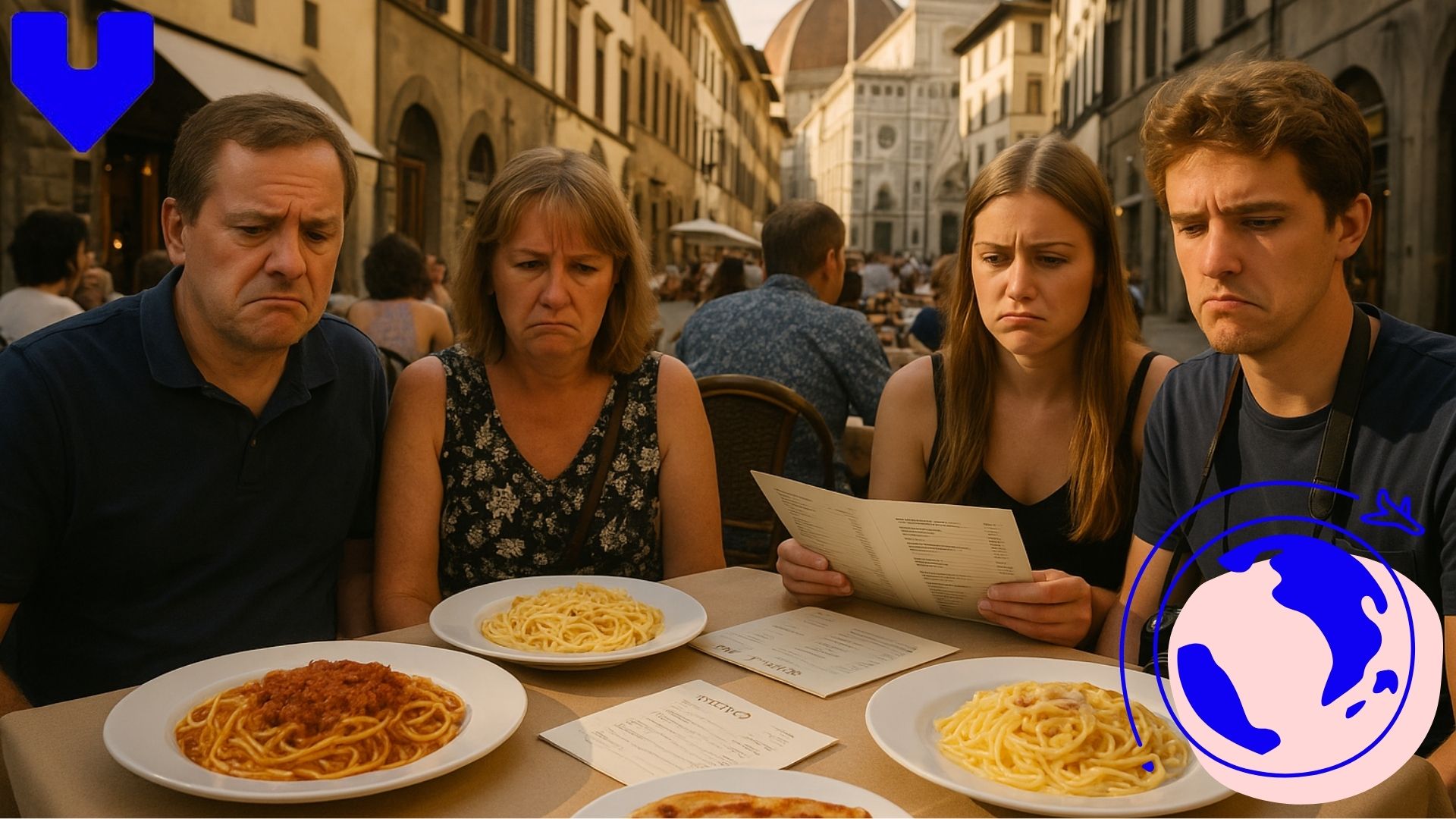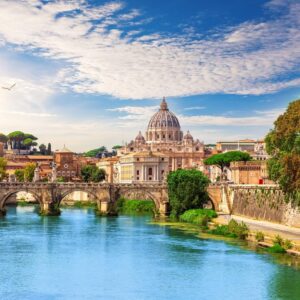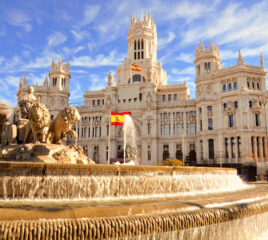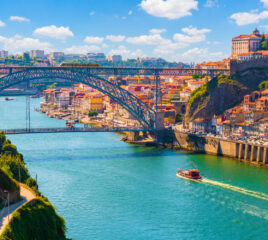Note that iPhone devices from Mainland China aren’t eSIM compatible. Also iPhone devices from Hong Kong and Macao aren’t compatible (except for iPhone 13 Mini, iPhone 12 Mini, iPhone SE 2020 and iPhone XS)
Florence is a city that inspires travelers with its Renaissance art, cobblestone streets, and breathtaking views of the Arno. But beyond the galleries and piazzas, food plays an equally important role in the city’s charm. Tuscan cuisine is rustic, bold, and deeply tied to the land – think earthy olive oils, hearty bean soups, and perfectly grilled meats.
Yet, as much as Florence is a food lover’s dream, it’s also a place where many visitors stumble into tourist traps. Brightly colored gelato, fake Florentine steaks, and overpriced pasta dishes often lure travelers who don’t know better. To truly enjoy the city’s flavors, it’s just as important to know what not to eat as it is to know what to try.
Why You Should Know What Not to Eat in Florence?
Every year, thousands of travelers arrive in Florence expecting flawless food experiences, only to leave disappointed because they fell into the wrong trattoria or café. The truth is, Florence’s historic center is designed as much for visitors as for locals, which means certain dishes are sold not for authenticity, but for profit.
Understanding what not to eat helps you:
- Avoid overpriced and low-quality meals.
- Identify real Tuscan flavors versus “tourist menus.”
- Save money for dishes that are worth the splurge.
- Appreciate Florence’s food scene the way locals do.
In a city where every meal has the potential to be unforgettable, knowing the pitfalls makes all the difference between a forgettable bite and a truly authentic experience.
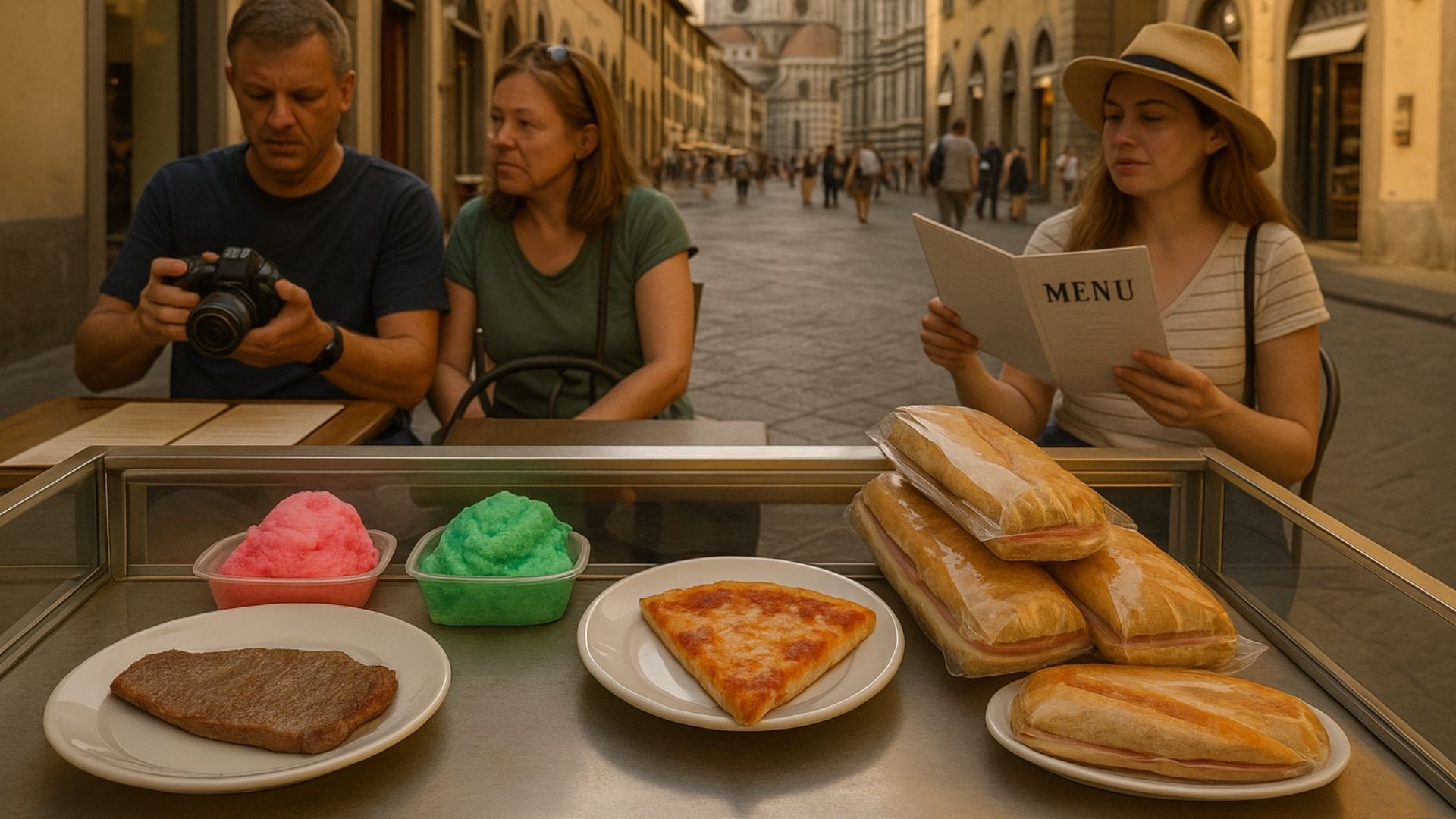
The Charm of Florentine Cuisine and Its Pitfalls
Florence is one of the world’s great food capitals, drawing visitors with promises of rustic trattorias, buttery pastries, and iconic Tuscan flavors. The city offers unforgettable culinary experiences, but like any tourist-heavy destination, it also comes with its share of pitfalls. For every family-run trattoria, there’s a tourist-trap café serving overpriced reheated pasta. For every artisanal gelateria, there’s a brightly colored counter full of artificial flavors waiting to disappoint.
This first section of our guide will walk you through the most common mistakes visitors make when eating in Florence. From fake steaks to overpriced snacks, understanding what not to eat will help you avoid wasting money and calories on the wrong meals – and ensure your time in Florence is filled with authentic tastes.
Overpriced Gelato Shops
Few foods represent Italy like gelato, and Florence has some of the best in the country. But not all gelato is created equal. One of the biggest traps is falling for the neon-colored, piled-high gelato displays you’ll find around the Duomo and Ponte Vecchio.
Real artisanal gelato is made with fresh fruit, nuts, and natural ingredients. Its colors are subtle, not fluorescent – think muted pistachio green, pale strawberry, and creamy chocolate. Authentic gelato is stored in covered tubs to preserve texture and temperature. Shops with mountains of gelato spilling over the edges of containers are almost always using artificial powders and pre-mixes.
Local tip: Try shops like Gelateria dei Neri or Vivoli, where gelato is made fresh daily. Prices are fair, flavors are seasonal, and the texture is smooth, not icy.
The Fake Florentine Steak
No dish is more synonymous with Florence than the bistecca alla Fiorentina – a massive T-bone steak grilled over coals, charred outside, and rare inside. Unfortunately, not every restaurant serves the real deal.
A genuine Florentine steak must meet strict criteria:
- It comes from Chianina cattle, a heritage Tuscan breed.
- It weighs at least one kilogram (meant for sharing).
- It is cooked rare, never well-done.
Many tourist-focused restaurants advertise “Florentine steak” but serve imported cuts, cook them medium-well, and charge per 100 grams without a clear explanation – leading to shocking bills.
Local tip: Always check if the menu states the breed and weight. Locals head to Trattoria dall’Oste or Perseus for an authentic bistecca experience.
Browse Italy eSIM Plans
Find reliable data options for Rome and all Italian cities.
Disappointing Pizza in Florence
Visitors often expect amazing pizza everywhere in Italy, but Florence is not Naples. While you can certainly find good pizza, many touristy trattorias serve subpar versions:
- Pre-made dough instead of fresh.
- Gas ovens instead of wood-fired.
- Heavy toppings that mask poor-quality crust.
If pizza is on your Florence bucket list, look for a place with a wood-burning oven and a short, seasonal topping menu. Avoid restaurants with laminated “pizza and pasta” menus in five languages – a sure sign of tourist fare.
Pre-Made Panini Shops
Panini are a Florentine tradition, but like gelato, not all panini are authentic. Shops that stack dozens of pre-filled sandwiches on the counter often use low-quality bread and supermarket cheeses.
True Florentine panini are made fresh to order, using rustic schiacciata bread filled with local specialties like:
- Finocchiona salami (fennel-spiced pork).
- Pecorino Toscano cheese.
- Porchetta (slow-roasted pork).
Local tip: Visit All’Antico Vinaio, one of Florence’s most famous panino shops, but expect long lines. For a quieter experience, try I’ Girone De’ Ghiotti.
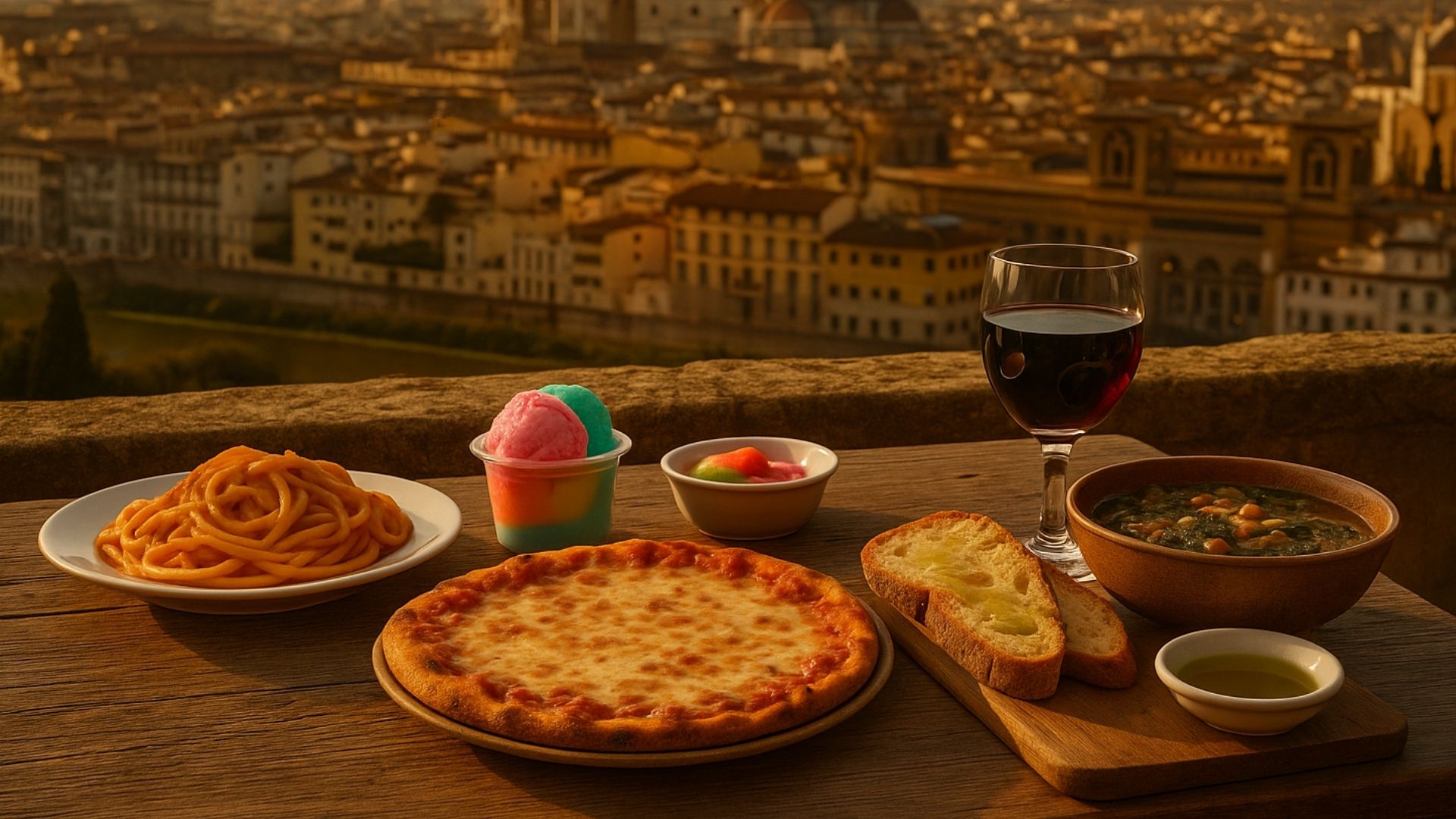
Pasta Dishes That Aren’t Really Florentine
One of the biggest mistakes is ordering pasta dishes that are marketed as Tuscan but aren’t traditional to the region. Florence is not Bologna or Rome, so don’t expect authentic Spaghetti Bolognese or Carbonara here.
Instead, locals prefer:
- Pici cacio e pepe – thick, hand-rolled pasta with pecorino and pepper.
- Pappardelle al cinghiale – wide noodles with wild boar ragu.
- Ribollita – a hearty bread-and-vegetable soup, often mistaken for pasta.
Tourist traps will push generic pasta plates with reheated sauces. If the menu looks like it was designed for tourists, it probably was.
Stay Connected In Florence
Choose traveler-friendly packages with easy activation and clear pricing.
Street Food Pitfalls
Florence has fantastic street food, but only if you know where to look. The city’s signature snack, lampredotto (a sandwich made with cow stomach), is delicious when prepared properly. However, many vendors near major piazzas sell low-quality versions just to attract tourists.
Local tip: Find the old-school carts near Sant’Ambrogio Market or Piazza della Repubblica, where locals line up during lunch.
Overpriced “House Wine”
Tuscan wine is legendary, but some trattorias take advantage of visitors by charging steep prices for average wine labeled as “house.” Authentic trattorias will offer Chianti Classico, Montepulciano, or Brunello at fair prices, often by the carafe.
If a place pushes wine without a proper label or charges suspiciously high prices per glass, it’s likely a tourist-focused venue.
Packaged “Tuscan” Souvenirs
Markets like the Mercato Centrale are must-sees, but not every product is genuine. Vacuum-sealed packs of truffle oil, porcini, or biscotti are often industrial, not artisanal. Authentic Tuscan products come from small vendors, and the difference in taste is striking.
Local tip: Avoid buying in bulk from stalls that look too polished. Instead, head to family-run delis in neighborhoods like Oltrarno.
Staying Connected While You Explore
When wandering Florence’s winding streets in search of authentic food, reliable connectivity is invaluable. You’ll need it to check reviews, use maps, or translate menus. Traditional SIM cards can be frustrating, but with Voye Global’s eSIM, you can activate instantly and enjoy seamless data across Italy.
That way, you’ll always know where to find the best gelato – and which steakhouse to avoid.
The Pasta Trap: Dishes That Aren’t Really Florentine
One of the most common food mistakes travelers make in Florence is ordering pasta dishes that don’t belong to Tuscany at all. Many menus designed for tourists will feature items like Spaghetti alla Carbonara, Lasagna Bolognese, or Penne all’Arrabbiata, all of which are delicious in their respective cities but not authentic to Florence.
Florentine and Tuscan cuisine lean more toward soups, beans, and meat dishes than pasta. When locals do eat pasta, they focus on rustic, hearty flavors that showcase regional produce and game.
Instead of wasting time on “pan-Italian” dishes, opt for:
- Pappardelle al Cinghiale: wide noodles served with a rich wild boar ragu.
- Pici all’Aglione: thick hand-rolled pasta with tomato and garlic sauce, a specialty of southern Tuscany.
- Ribollita: though not a pasta, this bread-based soup is a true Florentine favorite.
Tip: If you see a restaurant with menus in five languages showcasing “Spaghetti Bolognese” under a Florentine flag, walk the other way.
Explore Italy Without Limits
Install your eSIM in minutes and start using data instantly.
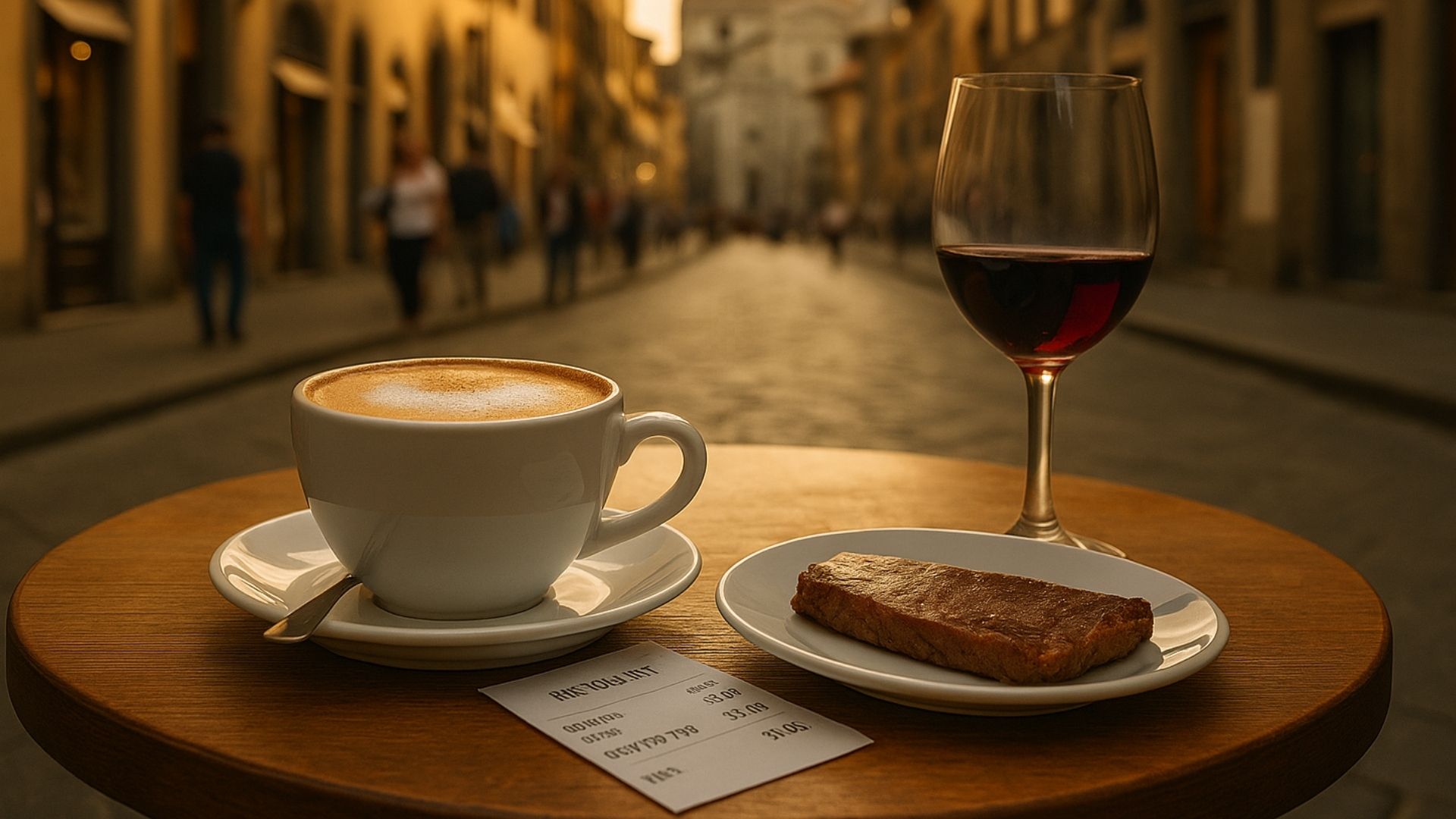
The Hidden Cost of House Wine
Tuscany is one of the most famous wine regions in the world, yet some visitors leave disappointed because they unknowingly paid too much for generic “house wine.”
Here’s what to watch out for:
- Tourist menus often list house wine at inflated prices while pouring low-quality blends.
- Some trattorias bring out unlabeled bottles or carafes with no mention of the vineyard.
- If a waiter pushes house wine too aggressively, it’s a sign they’re upselling you.
What to order instead?
- Chianti Classico DOCG: iconic red wine made just outside Florence.
- Brunello di Montalcino: pricier but worth it for special occasions.
- Vino Nobile di Montepulciano: another Tuscan gem that locals love.
True trattorias will happily serve these wines at fair prices. If in doubt, ask for a mezza caraffa (half carafe), which locals often order with meals.
Coffee Mistakes in Florence
Italian coffee culture is sacred, and Florence is no exception. Unfortunately, many visitors commit faux pas without realizing it.
Don’t:
- Order a cappuccino after 11 AM (locals see it as a breakfast drink).
- Expect fancy syrups or oversized lattes – Italian coffee is minimalist.
- Pay extra to sit down in tourist cafés near Piazza della Signoria.
Do:
- Stand at the bar and drink your espresso like a local.
- Pay at the register first (in many places) before handing your receipt to the barista.
- Try a macchiato if you want a small shot with just a drop of milk.
The Mercato Centrale Tourist Trap
The Mercato Centrale is one of Florence’s biggest attractions, and for good reason: it’s bustling, vibrant, and full of food stalls. However, many stands in the main tourist areas sell overpriced packaged goods rather than authentic Tuscan specialties.
What to avoid:
- Plastic-sealed biscotti labeled as “Tuscan.” They’re often industrially made.
- Cheap truffle oils that rely on synthetic flavors rather than real truffles.
- Pre-packed cheese with high tourist markups.
Instead, shop at the ground-floor butcher counters, fresh produce stands, or at Sant’Ambrogio Market, where locals buy daily essentials at fair prices.
Street Food Red Flags
Florence is famous for lampredotto, a tripe-based sandwich that is one of the city’s most traditional dishes. However, not every lampredotto is worth trying.
Avoid:
- Vendors parked directly outside major tourist attractions.
- Sandwiches where the meat looks dry or is pre-cooked hours earlier.
Seek out carts near local neighborhoods where workers line up on lunch breaks. The freshness and flavor will be worlds apart.
Sweet Pitfalls: Fake Pastries and Desserts
Tuscan desserts can be heavenly – think cantucci biscotti with vin santo, castagnaccio (chestnut cake), or schiacciata alla fiorentina (a Carnival specialty). But if you buy them in the wrong place, you’ll get a disappointing, dry version.
Tourist cafés often stock factory-made pastries with little flavor. A good rule: if the display case looks too shiny and filled with endless options, it’s probably not artisanal. Instead, head to local pasticcerias where pastries are made in small batches.
Stay Connected In Rome
Choose traveler-friendly packages with easy activation and clear pricing.
Connectivity and Smart Dining Choices
Finding authentic food in Florence often requires navigating beyond the tourist areas. Apps like Google Maps, TripAdvisor, or The Fork can help you spot the trattorias that locals trust. But to use them without constant stress about roaming charges, you’ll need seamless data.
This is where the eSIM for Italy makes all the difference. With Voye Global’s eSIM, you don’t have to waste time searching for a physical SIM card. You can stay online the entire trip, quickly cross-check restaurant reviews, and avoid the trap of overpriced meals.
Whether you’re wandering Oltrarno’s backstreets or exploring markets in Sant’Ambrogio, connectivity ensures you always find the authentic over the artificial.
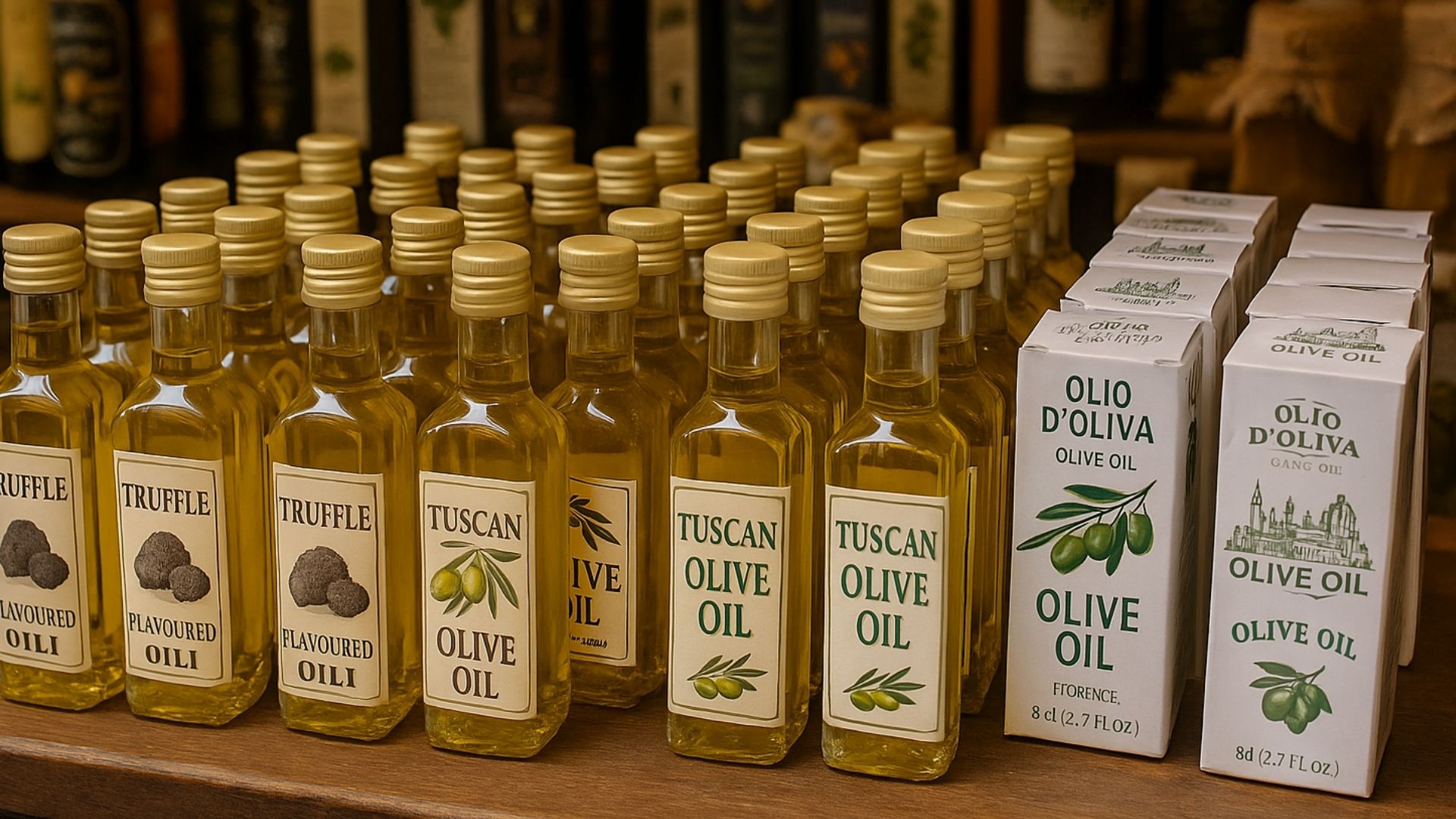
Truffle Products: The Tourist Illusion
Tuscany is renowned for its white and black truffles, but they are rare, seasonal, and expensive. Many shops in Florence sell cheap truffle oils, salts, or spreads that contain no real truffle at all. Instead, they use 2,4-dithiapentane, a synthetic chemical that mimics truffle aroma.
How to avoid this trap:
- Real truffle products are always pricey – if it feels cheap, it’s fake.
- Look for products labeled “tartufo fresco” with a harvest year.
- Taste before you buy if possible.
Olive Oil: Not All Bottles Are Equal
Another common mistake is buying olive oil from glossy souvenir shops. Florence is surrounded by olive groves, but authentic Tuscan extra virgin olive oil is typically sold in darker bottles to protect it from light, often with a DOP (Protected Designation of Origin) label.
Avoid clear bottles and flavored oils sold in bulk tourist shops. Instead, buy from trusted producers or at specialty food markets.
Sweet Temptations That Disappoint
Florence has a long tradition of pastries and sweets, but not every dessert lives up to the hype. Many tourist cafés along Via dei Calzaiuoli or near the Duomo serve pre-packaged biscotti or stale pastries that lack freshness.
If you’re seeking authentic sweetness, avoid:
- Factory-made cantucci biscotti are sold in decorative tins.
- Overly frosted cakes that don’t belong in Tuscan tradition.
- Mass-produced gelato cakes with artificial coloring.
Instead, look for small pasticcerias frequented by locals. Places like Pasticceria Giorgio or Scudieri deliver authentic Tuscan treats like cantucci with vin santo, schiacciata alla fiorentina, and zuccotto.
Packaged Truffle Products
Tuscan truffles are rightly famous, but the majority of cheap truffle oils and salts you’ll see in Florence are synthetic. If you’re tempted by truffle souvenirs, remember: real truffle flavor is delicate and seasonal.
- Avoid: bottled oils labeled “truffle flavored” without harvest details.
- Choose: fresh truffle dishes in season (October to December for white, January to March for black).
If you want authentic truffle products, visit certified specialty shops like Procacci Firenze.
Olive Oil Mistakes
Tuscan olive oil is another iconic product often misrepresented in Florence. Shops near major attractions sometimes sell olive oil in clear bottles – a sure sign it’s industrial and of poor quality.
Authentic Tuscan olive oil should be:
- Sold in dark glass bottles or tins.
- Labeled DOP or IGP, ensuring geographic authenticity.
- Fresh from the latest harvest.
Buying oil in the wrong place not only wastes money but also cheats you out of one of Tuscany’s best flavors.
Italy Coverage You Trust
Strong nationwide networks for Rome, Florence, Venice, and Milan.
International Chains in Florence
A mistake many travelers make is falling back on international fast-food chains. While familiar logos can be tempting after long days of sightseeing, they rob you of the true Florentine experience.
Florence offers incredible local fast-food equivalents:
- Panini shops that beat any sandwich chain.
- Pizza al taglio spots are perfect for a quick slice.
- Local cafés that deliver better espresso than global coffee chains.
Opting for authentic alternatives enriches your trip and supports local businesses.
Dining Near Major Squares
One golden rule: don’t eat right next to Florence’s landmarks. Restaurants near the Duomo, Ponte Vecchio, or Piazza della Signoria almost always charge more for lower quality.
Venture beyond the busy center and you’ll come across trattorias where locals actually dine, intimate places known for genuine warmth, better prices, and menus that change with the seasons. These spots capture the same charm found in Milan’s local food scene, where every dish tells a story of tradition and regional pride. Exploring such hidden corners brings a richer connection to Italy’s culture, much like traveling through Italy’s best cuisine cities, each celebrated for its signature flavors and timeless culinary heritage.
About Voye Global: Making Travel Seamless
Traveling in Florence is about savoring every bite, every sip of wine, and every moment spent in Tuscany’s capital. But to truly enjoy your trip, you need more than food knowledge – you need reliable connectivity.
Voye Global is here to make travel stress-free. With instant eSIM activation in over 170+ countries, including Italy, you’ll never worry about finding a SIM card shop or dealing with roaming fees.
Why Choose Voye Global for Your Trip to Florence?
- Instant setup: Download and activate within minutes.
- Affordable plans: Flexible packages for short or long stays.
- Reliable coverage: Works across Florence and throughout Italy.
- Trusted by travelers: Designed for explorers, digital nomads, and families alike.
Benefits for Food Lovers in Florence
With Voye Global’s eSIM, you can:
- Use food apps to check restaurant reviews in real time.
- Translate menus instantly to avoid confusion.
- Share your authentic Tuscan meals on the go.
- Navigate Florence without worrying about losing signal.

Frequently Asked Questions About Eating in Florence
1. What foods should I avoid in Florence?
Avoid fake Florentine steaks, neon gelato, pre-made panini, and overpriced pasta dishes not authentic to Tuscany.
2. Why is gelato near the Duomo so expensive?
Shops near major landmarks inflate prices and often serve artificial, low-quality gelato.
3. Is pizza a good choice in Florence?
Florence is not famous for pizza. If you want it, look for wood-fired ovens and seasonal toppings.
4. Are truffle oils in Florence authentic?
Most cheap truffle oils are synthetic. Authentic truffle dishes are seasonal and costlier.
5. What is the biggest dining mistake in Florence?
Eating at restaurants directly beside major attractions. Walk a few streets away for authenticity.
6. Do I need an eSIM in Florence?
Yes. With a Voye Global eSIM, you can stay online, check reviews, and avoid tourist traps.
7. How does Voye Global help food lovers?
It provides instant data to explore local markets, find authentic trattorias, and share experiences.
Seamless Mobile Data Everywhere







